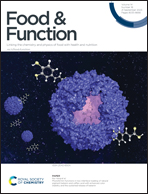Lactobacillus co-fermentation of Cerasus humilis juice alters chemical properties, enhances antioxidant activity, and improves gut microbiota†
Abstract
Fermentation with Lactobacillus has been shown to improve the nutritional value of juice. In this study, Cerasus humilis juice was fermented using two commercial probiotics, namely, Lactobacillus acidophilus and Lactobacillus plantarum. The total antioxidant capacity (TAOC), viable count, chemical properties, antioxidant activity after in vitro digestion, and alterations in the gut microbiota composition of the fermented juice were investigated. After fermentation, the TAOC increased from 107.66 U mL−1 to 126.72 U mL−1; viable count increased from 5.85 lg (CFU mL−1) to 8.17 lg (CFU mL−1); and the contents of total phenols, total flavonoids, proanthocyanins, four organic acids, and 29 amino acids had changed. Overall, 47 compounds were identified in the juice, 20 of which were enriched after fermentation. Furthermore, Lactobacillus co-fermentation improved the antioxidant properties of the juice after in vitro digestion and increased the abundance of probiotics to regulate the gut microbiota. These findings illustrate the potential use of Lactobacillus acidophilus and Lactobacillus plantarum in the co-fermentation of C. humilis juice to enhance its nutritional and functional properties.

- This article is part of the themed collection: Food & Function HOT Articles 2023


 Please wait while we load your content...
Please wait while we load your content...